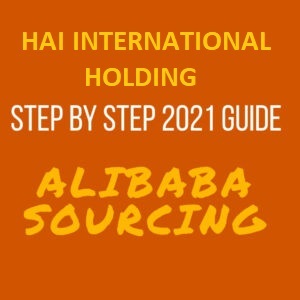Alibaba Domination.
Alibaba operates in MORE THAN 200 countries and territories. It is the world’s single largest online marketplace, as well as one of the largest internet and AI companies, and one of the largest VC firms in the world. Its online sales have surpassed all US retailers (including eBay, Amazon, and Walmart) combined since 2015.
Is Alibaba.com where you’re heading to find your suppliers?
Thousands of suppliers are listed on Alibaba, but not all of them are direct manufacturers, and not all of them are honest business people.
There are plenty of resellers and middlemen who are ready to take a cut of your profits, and sometimes, if you’re not careful, there are disreputable people on Alibaba who will scam your money if they can.
In this article, I will give you 4 SIMPLE STEPS to help you find the direct factories on Alibaba.
I have worked in sourcing for almost 20 years; what I am going to share with you will save you a great deal of trial and error.
Contents
PART 1 Let’s start by laying out our Research Rules
Rule #1: STOP looking at the unit price and the minimum order quantity (MOQ).
What? Yes. What? Yes. STOP looking at the unit price and the MOQ when you start your research. Price and MOQ mean nothing to us at this point.
We are shopping for quality suppliers first and then, when we’ve identified those suppliers, we will negotiate the price and then MOQ.
Rule #2: RESIST “product temptation.
Alibaba’s default search setting is by “Product.”
If you type in “yoga mat,” the most colorful yoga mat pictures will pop up, product after product, page after page…it’s so easy to get sucked into the product listings.
Once you’ve been drawn in, after hours of surfing, you will be exhausted, but you’ll still be seeking a good factory.
So Rule # 2 is to resist the temptation of clicking on product listings. But if you’re not looking at the product listings, what should you do? Read on.
Rule #3: KNOW the algorithm and take advantage of it.
Alibaba.com is similar to Amazon.com, in that its search engine algorithm uses built-in filters. The pyramid below demonstrates how those filters are applied.

What you need to know is how you can gain access to those suppliers who are congregated at the TOP of the pyramid.
Let me return to the yoga mat as an example and show you how.
If you type “yoga mat” into the search field, 100,000+ yoga product listings will pop up. It would be impossible to effectively sort out some 100,000 product listings.
Following the first two Research Rules we outlined above – not looking at the Price or MOQ, and not clicking on any of the product listings – we now take the following steps.
Sort the 100,000 listings by Suppliers.
We will find that those 100,000+ products are actually only sold by about 900 suppliers. But to go through 900 suppliers is still a daunting task – especially when we only want to submit our requests for quote (RFQs) to the top 10 suppliers. This is why we need to continue to apply filters.
Check the “Verified Suppliers” box.
Who are the “Verified Suppliers”?
The “Verified Supplier” status indicates a paid membership. Previously, Alibaba called this membership the “Gold Supplier” status – a Gold Supplier has the “gold” to pay, simply put.
Check the “Trade Assurance” box.
What is Trade Assurance?
Trade Assurance is a free service offered by Alibaba.com, designed to help create trust between buyers and suppliers. Trade Assurance covers buyers with 100% payment protection from their selected Trade Assuran-ce suppliers.
In most cases, if you sort by Suppliers and apply these two additional filters, the total supplier count will drop quite a bit. In the case of the yoga mat, 900+ suppliers will be narrowed down to 200+ suppliers. 200+ suppliers is a manageable quantity. Once again, we only need the top 10 suppliers to send out our RFQs.
After we get the raw list of 200+ yoga mat suppliers, let’s move on
PART 2 : 4 SIMPLE STEPS to find the Best Direct Factories
STEP 1: Who Are They?
This is meant to be just a quick scan of the supplier’s basic profile, before you dive in too deep and potentially end up wasting time.
Who Are They? Business Name:
4 Essential Elements in a Chinese Company Name
TIP: Chinese Business Name
A Chinese supplier’s name is very structured. All Chinese business names include 4 essential elements, so you can learn a lot just by looking at a busi- ness name. Let’s take a look at an example:
Business Name: Ningbo Pidegree Plastic & Rubber Industry Co., Ltd.
What are the 4 elements in this business name?

By breaking down the supplier’s name you can see that this supplier:
- It is registered in Ningbo, a city in Zhejiang
- If you don’t know the city name at all, do a quick Google search.
- The official company name is
- The main business is focused on plastic- and rubber-type
- It is a limited liability
TIP: Element A
If the supplier is registered in the city of Ningbo, the company cannot name the business Zhejiang Pidegree. Zhejiang is a province, one level above Ningbo.
What about China Pidegree? 100% no. Only the companies that are registered on the state level can use “China” as this first element – for instance, China Telecom.
TIP: Element B
The keyword in Element B gives a hint of the company’s business concentration. If the company is a trading company, you will see a much more generic description. Compare these two names:
- Ningbo Pedigree Plastic & Rubber
- Ningbo Pedigree Sports & Fitness
If both suppliers are listing yoga mat products on Alibaba, I would say that Supplier A is most likely a direct factory, and Supplier B is most likely a trading company. A “Plastic & Rubber” company is most likely vertically integrated with equipment, materials, etc. related to plastic. A “Sports & Fitness” com- pany is most likely horizontally positioned to cover as many types of products as possible.
TIP: Exceptions
Foreign registered companies doing business in China will use this alternate naming structure:

Who Are They? Business Type
The suppliers on Alibaba are required to disclose whether they are a manufaturing company or a trading company.
To see the disclosure, first click on “View Company Profile.”

After you open the supplier’s Company Profile page, you can read their disclosure on their business type.

Question: Why does the supplier in this example declare that it’s both a manufacturer AND a trading company?
Answer: When a supplier can fabricate products, but also has a license to export their products, they can list the business type as both “Manufacturer” and “Trading Company.”
However, if the supplier doesn’t own a factory, the business type should be “Trading Company.” Look at the example below.
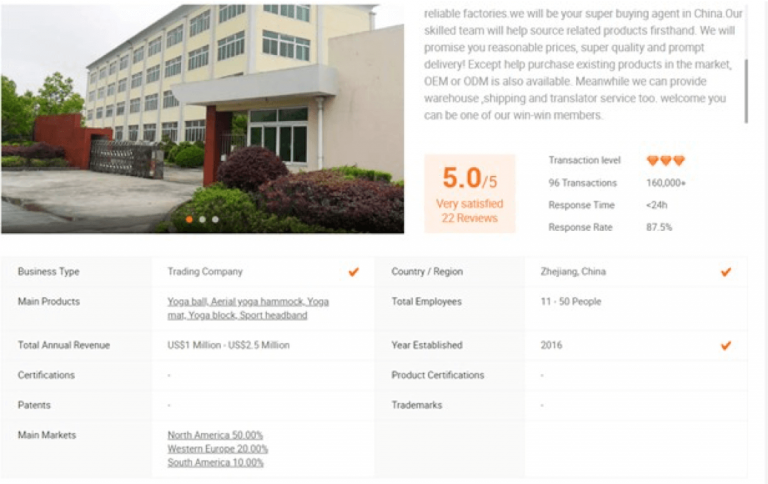
TIP: Why do trading companies exist?
Trading companies exist because not all Chinese factories have an export license.
Export licenses are highly regulated in China, and are quota-based. Let’s say a company has an export license and the quota for the year isn$10M. If the company doesn’t meet this quota, the license will need to be reviewed or removed.
This depends on the relationship between the trading company and its associated factory (or factories). Some trading companies have a very close relationship with their factories.
In such cases, the trading company might list the factory’s products and equipment on Alibaba, effectively functioning as a sales office for the factory and taking a commission on the sales of the factory’s products.
How do we peel back the layers and find out if the trading company is taking charge? I’ll share some tips later in this article.
Who Are They? Number of Employees
The number of employees is a telltale sign as to whether a supplier is a direct factory or not.
- A company that has fewer than 50 employees is very likely to be a trading company.
- A company that has more than 500 employees is a large company, and most likely a direct factory.
TIP: Find your “match” in the bucket of suppliers with 50-500 employees.
If you’re a small startup company with limited funds, just getting onto the Amazon FBA journey, pay attention to the suppliers in this bucket for the following reasons:
- A small company (< 50 people) – even if it is a direct factory – may not be very dependable because it could be a “mom-and-pop” shop – more tribal knowledge, fewer processes, less consistency in product
- A large company (> 500 people) is likely to a direct factory, but will tend to ask for a higher MOQ, and is often less flexible to work
Must read: HOW TO START ON AMAZON FBA IN 2021
Who Are They? Number of Years Selling on Alibaba
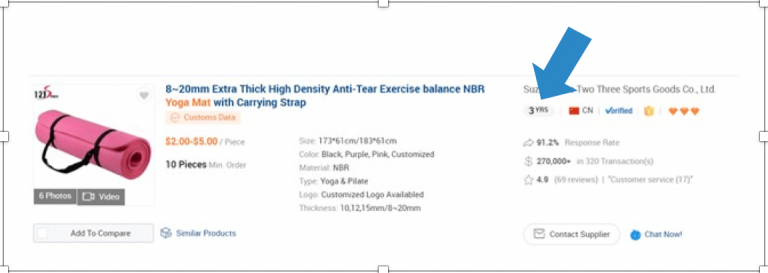
Why does the number of years selling on Alibaba matter?
Alibaba.com is an export market-facing platform, and the quality standard from customers in the United States and Europe is higher than it is for domestic market-facing platforms such as 1688.com.
For any Chinese factory to use Alibaba.com as its sales platform – and also consistently succeed on Alibaba – it needs commitment in everything from product quality to communication quality. The company needs to stay consistent and competitive.
Remember that Gold Supplier pays an annual premium for its membership. The longer it’s been a Gold Supplier, the MORE confidence you can place in this supplier for its stability, quality consistency, and accumulated export experience.
TIP: I would recommend a minimum of 3 years of Alibaba selling experience as your supplier requirement. You don’t want to babysit a new Ali- baba supplier – or in the worst-case scenario, have it disappear on you. This would spell disaster, especially if you’re using your savings to start your Amazon FBA business.
STEP 1 RECAP:
In Step 1, we quickly learned a little bit about our potential supplier, through its business name, business type, number of employees, and number of years selling on Alibaba.com.
We gleaned some good insight into the supplier’s profile, but that
information alone is not enough to justify proceeding with a direct factory. We now need MORE information.
STEP 2: What They Do?
Remember when I said earlier that a trading company is more likely to be horizontally expanded into different types of products, versus a factory, which is more vertically integrated with equipment and materials? In Step 2, we’re going to take a deep look into a supplier’s product, production capability, and product quality.
What They Do? Product Concentration
It’ll be easier if I use these two examples to illustrate product concentration.
Supplier A:

Supplier B:
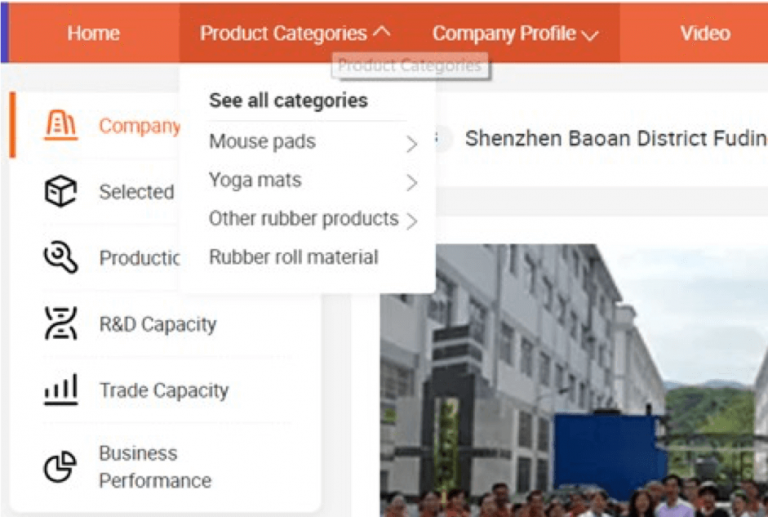
If you knew nothing about Supplier A and Supplier B, and someone told you about them by describing their products, which supplier you chose?
If you have chosen Supplier B, then you’re on the right path to finding a direct factory.
Supplier B produces mouse pads, yoga mats, rubber roll material, and other rubber products, all of which are in the same product category – plastic and rubber.
Compare this to Supplier A, who is engaged in all kinds of fitness products, including free weights, battle ropes, and yoga mats. The great variety in product categories makes it impossible for a small- or medium-sized factory to produce efficiently.
TIP: Know the benefits.
Here are some benefits for a supplier who is focused on only one type of product:
1/ Material cost The supplier, buying relatively fewer materials at higher volumes, can leverage its buying power and negotiate better material price.
2/ Worker The workers are trained to do one type of work, day in and day out, fostering higher production efficiency and quality consistency.
3/R&D The factory that’s been making this type of product and has survived for years and years knows what works and what doesn’t. If you are customizing your private-labeled product, such a factory could quickly give you their feedback on your idea.
What They Do? Production Capabilities
What you are looking for? Machinery and process steps.
You might not have the knowledge around yoga mat production machinery or process steps, but after comparing several suppliers, you’ll start to get some ideas

TIP: These photos will have very little meaning if you don’t know how to ask the right follow-up questions, because any supplier can post pictures of its machinery and production flow. To know a supplier’s true production capabilities, ask these follow-up questions:
“How many foaming machines do you have on your production floor?” “How many cutting stations?”
“How many pieces of rolling equipment?”
TIP: if you ask these questions on the spot with your sales rep, not only will it make you sound like a professional buyer, but it can also help you test if the sales rep actually works in the factory. If you ask through an e-mail, of course, you’re giving them time to find out any answers they don’t know.
What They Do? Product Quality
Tricky Question: if you must make a choice between an ISO certificate and a product certification, which one do you think is MORE important?
If you’re a big company, both are probably equally important. If you’re a small company with limited funds, though, the answer is product certification.
Why?
An ISO certification is surely nice to have. It’s a certification given only to compa- nies with systems in place that meet the requirements of International Organization for Standardization.
I have been working in the sourcing function for nearly 20 years. I have worked with and audited many suppliers around the world – some have ISO certificates and some don’t.
The truth is, a company that has ISO certification doesn’t necessarily generate any better product quality that a company without an ISO certificate.
What we are looking for? We are looking for MORE. The MORE product certifications the supplier can provide, the higher confidence we have with their product quality.
For example, between Supplier A and Supplier B below, which supplier likely has better product quality?
Supplier A:
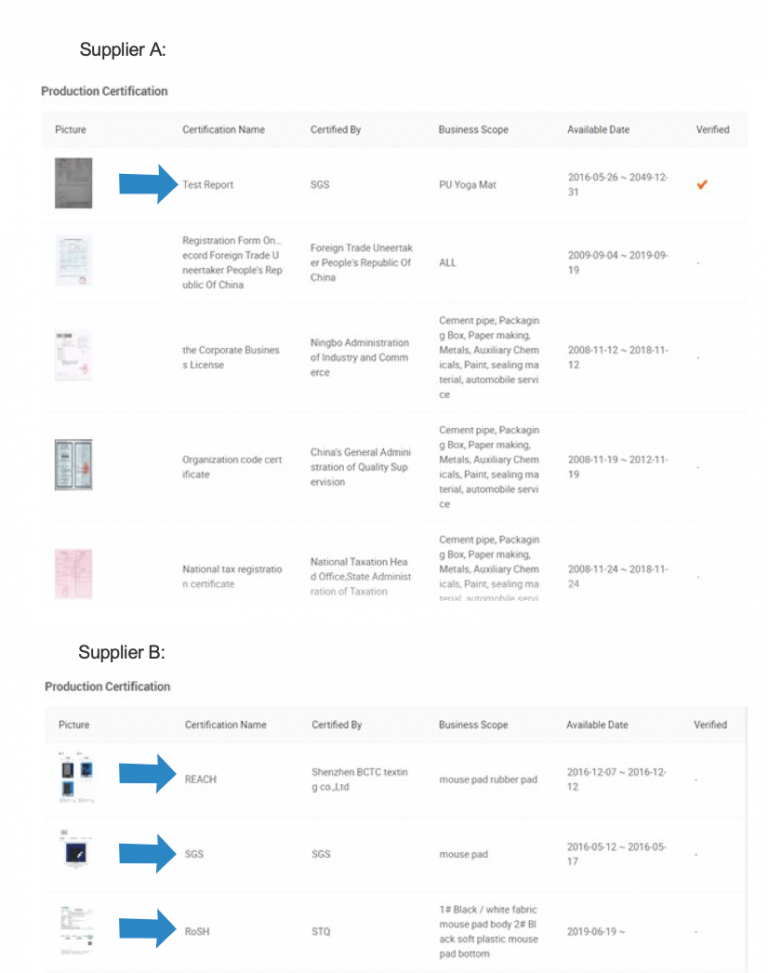
You probably know the answer already; it’s Supplier B. Why?
If the supplier is willing to spend money to get its products tested through multiple test agencies, this raises our confidence level.
TIP: Checking the supplier’s certification listings will give you some idea of the certifications needed or expected for your product. Please be aware, each country can have different product certification requirements.
For example, RoSH is a mandate within EU countries. A certain yoga mat can be sold to the US or to Australia, but not to the UK market if one raw ma- terial used in its construction is classified as a toxic material on the RoSH material list.
The same yoga mat can be able sold to USA or Australia but not to the UK market if one raw material used in the yoga mat is considered toxic material according to RoSH material list.
STEP 2 RECAP:
In Step 2, we dug deeper into the supplier’s product concentration, production capability, and product quality.
We must add this to what we learned in Step 1 about who the supplier is. If we’re growing in our certainty that this supplier is a direct factory, then it’s time to determine where this supplier is located.
STEP 3: Where Are They?

In terms of manufacturing, China opened its doors in the 1980s. Within 20 years, made-in-China products had effectively flooded the world.
But specifically, where does the majority of manufacturing activity occur in China? On the map below, we see that most of it takes place in the blue zone – the coastal regions, where bustling seaports stand ready to receive millions of containers from nearby cities and send made-in-China products throughout the world
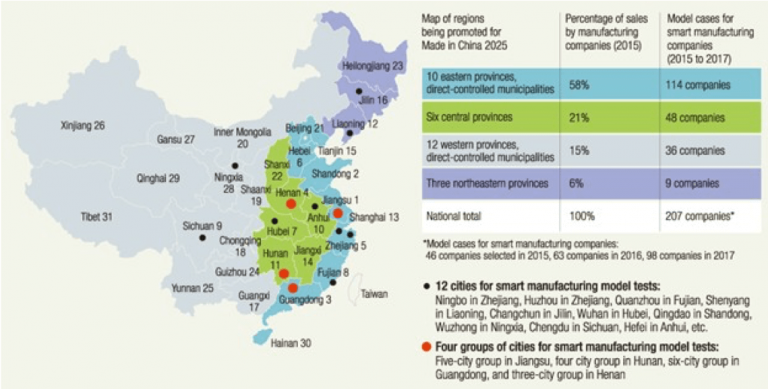
Source: Hitachi Review https://www.hitachi.com
Even though China is shifting its manufacturing activities to the green inland areas shown in the map above, for you, the small Amazon FBA business seller, it’s still quite important to utilize a factory in the blue zone.
Why?
Here are the reasons for keeping your factory in the coastal cities – the blue zone.
1/ The complete learning curve
The blue zone is where the first wave of made-in-China mass production started. Factories have already gone through the learning curve, quality has improved through 30 years of competition, and worker skills are higher than they are in the newer zones. As a small company, you’ll want to go with the time-tested supplier.
2/The efficient ecosystem
In China, there are certain cities that are largely concentrated on one type of product. For example, nearly all electronics are made in Shenzhen. As you can imagine, it’s not just finished electronics products that are made in Shenzhen, but all the necessary raw materials suppliers are congregated nearby as well – this entire ecosystem lives together in efficient concord.
If you found an electronics supplier in northern China, even if this factory were fully capable of producing your product, most likely they’re getting at least some of their components from Shenzhen.
3/ The hidden costs to watch for
Once you’re outside the blue zone, you’ll need to transport your products from inland China to the blue zone to access a seaport. This shipping element is a cost that may not be included in your quote. Furthermore, potential damage could occur during the course of inland transportation. These are the hidden costs that you need to weigh out when choosing an inland factory.
4/ Scale up, be strategic
The final point is that you have to think big and long-term. When you scale up, you may need 2, 3, 4, or 10 suppliers as you keep adding new products to your portfolio. It’s a relatively easy matter to consolidate your shipments into one container – and save a lot of shipping cost at the same time – when when your various suppliers are all in close proximity.
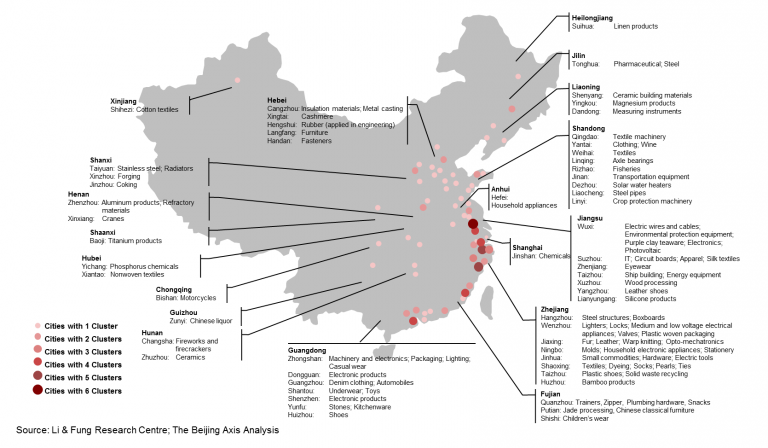
TIP: Do you want visibility on the major Chinese manufacturing cities and product concentrations? The map below will give you some general direction.
When looking for a specific product, note that the needed supplier could be totally outside of the province with the appropriate production concentration. Be diligent but flexible with your supplier selection.
TIP: Review provinces along the coastal line, below the Shandong province and all the way down to the Guangdong province. Ignore the 3 provinces to the northeast (Heilongjiang, Jilin, and Liaoning) when you’re first starting out.
TIP: The 5 major manufacturing provinces along the coastal line are Shan Dong, Jiangsu, Zhejiang, Fujian, Guangdong.
TIP: Shenzhen is a city of the Guangdong province. Guangdong City is the capital city of Guangdong Province.
STEP 3 RECAP:
In Step 3, we emphasized the benefits of using suppliers in cities near the coastline, for the benefits of shipping cost, quality control, and your future business scale-up consolidation.
Along the coastal line, try stay south of the Shandong province.
Northern cities are getting better; they’re catching up with the southerncities, but in or der to be efficient with y our sourcing, leave those 3 northern provinces out.
STEP 4: How Good Is This Supplier?
There are a few other qualifications we need to look at before we seriously consider a supplier to be a good partner.
How good Is This Supplier? Tradeshows
If a supplier indicates in its company profile that it has participated in some trades- hows, this is a positive sign:
- It suggests financial It’s expensive to register for and attend a trades- how. If a supplier can afford both the money and the sales personnel to attend the trade show, this is very positive. Most Chinese factories don’t attend tradeshows.
- It suggests company R&D When companies attend the trade show, normally new design and product offerings are introduced at the tradeshow.
TIP: Ask the supplier if they display customer private-labeled or customized products at tradeshows. If the answer is NO, it is a good sign because they are conscious about protecting their customers’ intellectual property.
How Good Is This supplier? “Surprise” Tests
Most supplier’s sales reps work inside the factory. It’s not common for a supplier to set up a separate sales office. Since we really want to find out “who’s behind the cur- tain,” we want to use 2 surprise tests to further verify if the supplier is a direct factory or a trading company:
Test 1:
“My agent just happens to be in the neighborhood; can he stop by for a quick visit?”
Test 2:
“Can we do a quick video call where you show me your production and shop floor areas?”
By listening to the response you receive, or by watching the facial expression of the sales rep (preferably you are on a WeChat or Skype call with your sales contact), you can glean vital clues:
a/ They may resist, hesitate, or defer your request (i.e. buy time).
b/ They may appear okay with your request and happy to show you their production
Test 3:
“It’s okay; you don’t have to go to the shop floor, but can you show me your showroom?”
TIP: A real factory’s showroom will display the factory’s products as you saw them on the Alibaba webpage. A trading company’s showroom (if there is one) is going to show a variety of products.
TIP: Be upfront with the salesperson and tell him that you are looking for a direct factory to work with: “If you’re a trading company agent, please tell me now because I’m going to find out sooner or later.”*Of course, you are going to say this with a happy emoji.
How Good Is This Supplier? English Skill
It is utterly frustrating to deal with a supplier who doesn’t understand you well. It is a must that you find a supplier who speaks adequate English.
What is adequate – is it basic, intermediate, advanced, or proficient? If the supplier contact can speak intermediate to advanced English, that’s a luxury. Most Chinese suppliers’ sales reps speak basic English, or basic-to-intermediate English.
Sometimes it’s hard to have them understand your requirements. Misunderstanding can get expensive, especially when it comes to your product exact specifications.
Even if the supplier’s sales rep speaks good English, you need to pay attention to their communication ACCURACY. I would personally prefer someone who speaks English less well, but is extremely detailed and thorough.
Keep your eyes on the big picture, but never lose sight of the details. Successful pro- duct execution is dependent on the sales rep’s understanding of your requirements, and on his ability to communicate those requirements to the factory engineer and then to the shop floor.
I have heard and personally experienced sloppy sales reps and it can easily exert atremendous influence on the successful outcome of your purchasing experience.
TIP: English skills – too good to be true?
Let’s say the supplier’s sales rep speaks such good English that you are more than impressed. Does it cross your mind that this supplier may be a trading company? Trading company employees, in general, speak above-average English, because these workers have normally graduated from a foreign language school, and they deal with over- seas customers on daily basis.
STEP 4 RECAP:
In Step 4, we took supplier qualification to another level by assessing the supplier’s English skills. If a supplier can pass the “surprise” tests, we will feel a lot more confident that this supplier is a direct factory.
CONCLUSION
There is a lot that can be done to further verify if a supplier is a direct factory or a trading company after you find it on Alibaba. There are a lot telltale signs during the sample stage and during the factory audit process.
The 4 steps I shared with you are meant for early-stage investigation, so you don’t waste time engaging with a supplier, only to find out later that they are just a middle- man.
Final note: Why try to avoid the middleman after all?
There are many benefits, from direct factory pricing advantage to R&D collaboration, but the one fundamental reason is this: you need to own the relationship. This is your business; you need to know who the real partner is.
About Jean Perri

I am the Manager of the HAI International Holding team.
The passion for sourcing runs deep in my blood otherwise I would not have done it for 10 years. My suppliers would say these 3 things about me: Jean is a tough negotiator, a strong relationship builder and a tenacious profit finder.
Out of all people, how could I become the top supply chain professional in the nation?
When I first came to the China, I had nothing and knew very little Chinese. But in my mind, there was an uncompromising desire to be the best in everything I do. I put myself through business school in China.
Professionally, I only want to compete in the most demanding companies. Some are Fortune 500s, some are Hi-Techs, some are small businesses, but all of them are incredibly competitive in the field of sourcing, that is exactly where I excelled.
The experience I gained through 10 years of sourcing is now condensed into HAI International Holding Sourcing program to serve more people. As I hold myself to the highest standard of honesty and integrity, I work hard to make sure HAI International Holding remain the best freight forwarder and sourcing company in China

